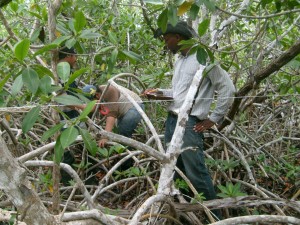One of the best things, obviously, about doing field work, is getting the chance to finagle yourself into areas where few people have, or will go. One of those times, I recounted already, when I headed into the selva de manglar near the Laguna de Mala Noche in Quintana Roo, with a monitoring team from Simbiosis SA de CV.
Yesterday, I headed back to Xcalak, where I was staying for a couple days around selva work; this time, however, I wanted to examine the Parque Nacional de los Arrecifes de Xcalak (PNAX). What I find particularly interesting about PNAX, is that it is a protected area established by the federal government, due in large part to local pressure by the local population of Xcalak, a small, politically and economically isolated fishing village on the southern-most tip of the eastern part of the United States of Mexico.

Location of Xcalak
Now, we usually think of protected areas and environmental regulation as restrictive, or at the very least, regulatory processes, limiting the kinds of human activity allowed in certain areas. Certainly, some of the regulations required by the creation of PNAX – the prohibition on the removal and clearing of mangroves; restricted fishing quotas and techniques; limits on the size, location, and number of hotel rooms – have effectively prevented the possibility of the kind of tourism that has brought so much foreign income to Cancún, Playa del Carmen, and the Riviera Maya. But, you see, that was the point. While not all fishermen were entirely happy with the federal regulations of PNAX (some were very bitter, for example, about restrictions on the capture of conch and lobster, which would be used in subsistence consumption), all the ones I spoke to were adamant that that kind of desorbitado development was not appropriate, economically, socially or environmentally, for the tiny, underdeveloped fishing village.
But, anyway, I digress. I drove to Xcalak, and managed to convince (i.e. pay) the head of the fishing cooperative to take me out to the reefs to take a gander. You see, the last time I was in Mexico, officials from the Comisión Nacional de Áreas Naturales Protegidas (CONANP) took me out on a reef monitoring trip in the Parque Nacional de Puerto Morelos, and I wanted to see how this section of the reef compared. Well, in short, it was… incredible. Simply incredible. I could go on about the vibrancy of the colours; the movement of the fan corals in the underwater currents; the section of the reef dedicated to the crianza of new corals; lobsters shooting themselves backwards on our approach. But I won’t. I will, however, say that on my tour around the reef park, I, with the eagle-eyes for which the Fuentes-George’s are rightfully famous, spotted the accursed Lionfish, the rat of the sea, that invasive species trying to take over our role as the destroyers of ecosystems. I called Oscar, the cooperative’s head, over, and with a small, spring-loaded spear, he impaled the lionfish right. Through. The. Mouth.
“In your face, stupid lionfish,” I thought. “If anybody is going to be an invasive species, it’s gonna be us.” Oscar said the fish would be taken to CONANP’s Xcalak office, right off the beach, to be tallied. Thereafter, the spines would be de-venomed, and made into artisanal jewelry, and someone would eat the filleted animal. I would have liked to eat the stupid fish myself, but alas, it was getting late, and the drive back to Chetumal would have to traverse unlit roads, bordered by mangrove swamps and forest, and I’d rather not do that after sundown. But, by finding that pendejo fish, I felt pretty happy that I could do one tiny, tiny thing to help keep the PNAX healthy.






